15 Types of Black Birds in Indiana (With Pictures)
Last Updated on
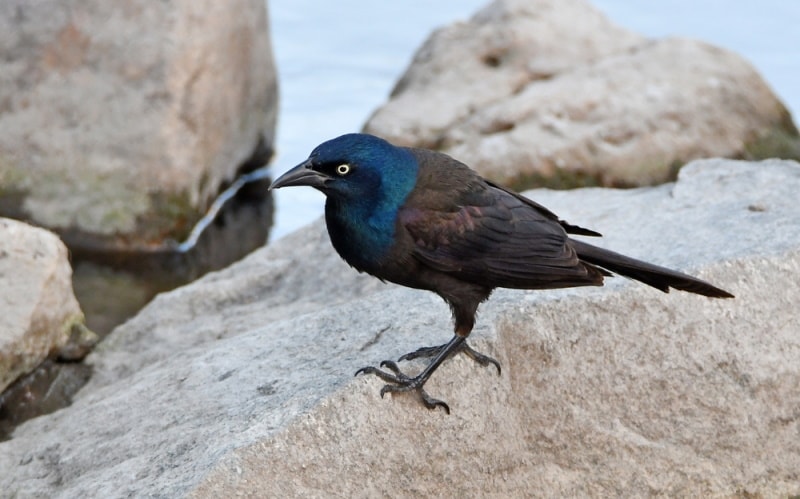
Black birds are a common sight in Indiana. There are many different types of black birds, each with its own unique appearance. If you’re interested in learning more about the different types of black birds that can be found in Indiana, read on!

The 15 Types of Black Birds in Indiana
1. Yellow-Headed Blackbird
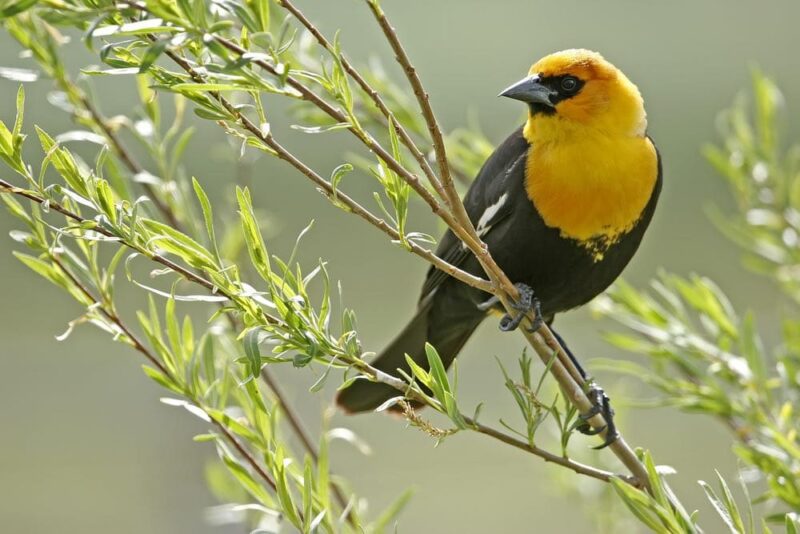
| Length | 8.3 to 10.2 inches |
| Wingspan | 16.5 to 17.3 inches |
| Weight | 1.6 to 3.5 ounces |
First up on our list of black birds in Indiana is the Yellow-headed Blackbird. As you can probably guess from its name, this type of blackbird has a yellow head. The rest of its body is black, except for a small patch of white on its breast. These birds are relatively large, measuring between 8 and 10 inches.
Moreover, they make unique sounds, which has been described as a “wheezy trill.” You’re most likely to spot a Yellow-headed Blackbird near marshes or wetlands.
2. Eastern Meadowlark

| Length | 7 to 9 inches |
| Wingspan | 13 to 15 inches |
| Weight | 3.2 to 5.3 ounces |
The Eastern Meadowlark is a blackbird that is commonly found in Indiana. It has a black body with yellow stripes on its breast and wings. This bird is also known for its distinctive song, which sounds like “meadowlark, meadowlark.”
It boasts a length of about 7–9 inches and a wingspan of 13–15 inches. This relatively small bird can typically be found in open fields and meadows.
3. Bobolink

| Length | 5.9 to 8.3 inches |
| Wingspan | 10.5 inches |
| Weight | 1 to 2 ounces |
The bobolink is a medium-sized blackbird with a short, pointed bill. The male has a black body with a white back and rump. The female is dark brown with some white on the wingtips. Both sexes have yellow eyes.
Bobolinks breed in open fields and meadows in the northern United States and southern Canada. They eat insects, seeds, and grains. In the winter, they migrate to South America.
4. Baltimore Oriole
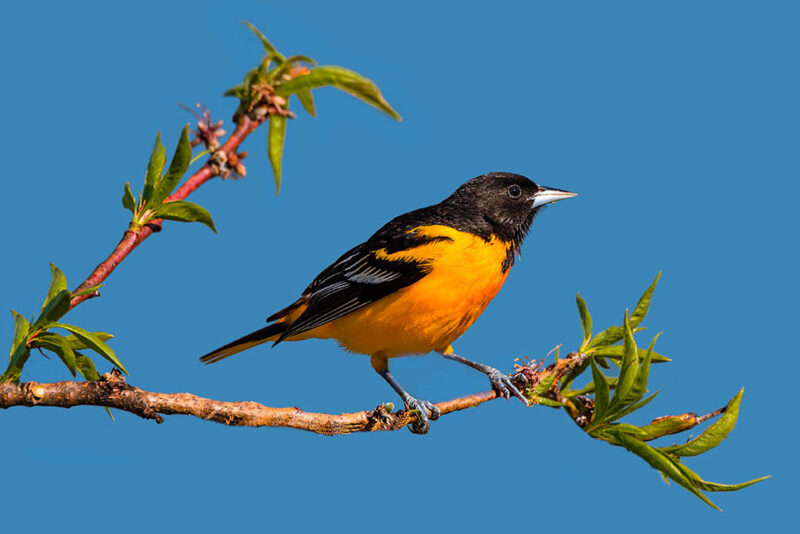
| Length | 6.5 to 7.5 inches |
| Wingspan | 6 to 10 inches |
| Weight | 1 to 1.4 ounces |
The Baltimore Oriole is the state bird of Maryland. It is also the official bird of that city, which was named after Lord Baltimore. However, it can also be found in Indiana. The Baltimore Oriole is a small black bird with an orange-yellow breast. It is about 6 inches long and has a wingspan of 10 inches.
This bird can be found in woods and forests. It nests in trees, often near water. The Baltimore Oriole eats insects, fruits, and nectar.
5. Red-Winged Blackbird
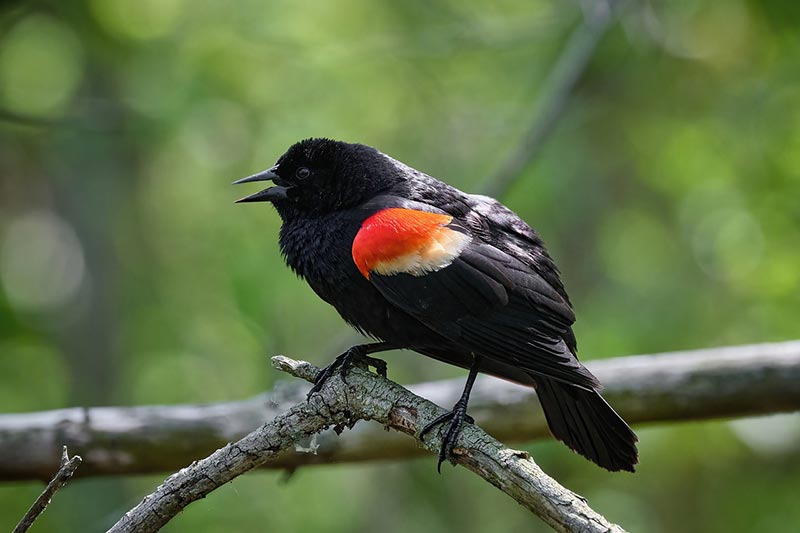
| Length | 9 inches |
| Wingspan | 12 to 15 inches |
| Weight | 1 to 2.7 ounces |
The Red-winged Blackbird is a species of true blackbird in the icterid family. males have distinctive red shoulder patches and brilliant yellow wing bars. They are found in open wetlands across North and Central America. Females are more subdued, with dark brown upperparts and paler underparts.
As a member of the icterid family, the Red-winged Blackbird is closely related to grackles, new world orioles, and meadowlarks.
The Red-winged Blackbird is sexually dimorphic, meaning that males and females look different. The male has distinctive red shoulder patches and brilliant yellow wing bars. Females are more subdued, with dark brown upperparts and paler underparts.
6. Orchard Oriole
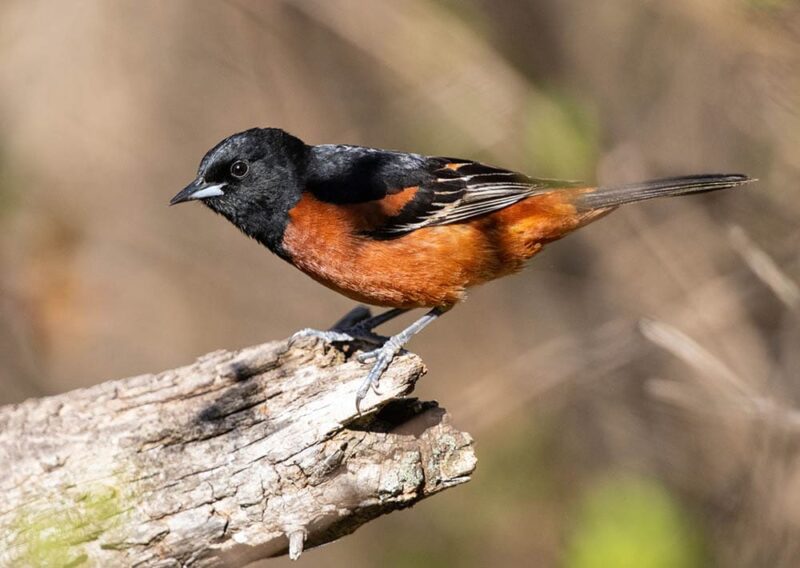
| Length | 6.3 to 7.6 inches |
| Wingspan | 10 to 12 inches |
| Weight | 0.5 to 1 ounces |
The Orchard Oriole is a small icterid bird. It is about 6.3–7.6 inches in length and has a wingspan of 10–12 inches. Males and females look similar, with both having black upperparts and bright orange-yellow underparts.
The male has a black breast band, while the female has a paler throat and breast. Juveniles are similar to adults but have browner upperparts and duller underparts.
The Orchard Oriole is found in woodlands, parks, and gardens near streams, rivers, or other bodies of water. It feeds on insects, spiders, berries, and fruits. The Orchard Oriole builds a cup-shaped nest out of grass, leaves, and other plant materials. The nest is usually built in trees or shrubs, often near water.
7. Brown-Headed Cowbird
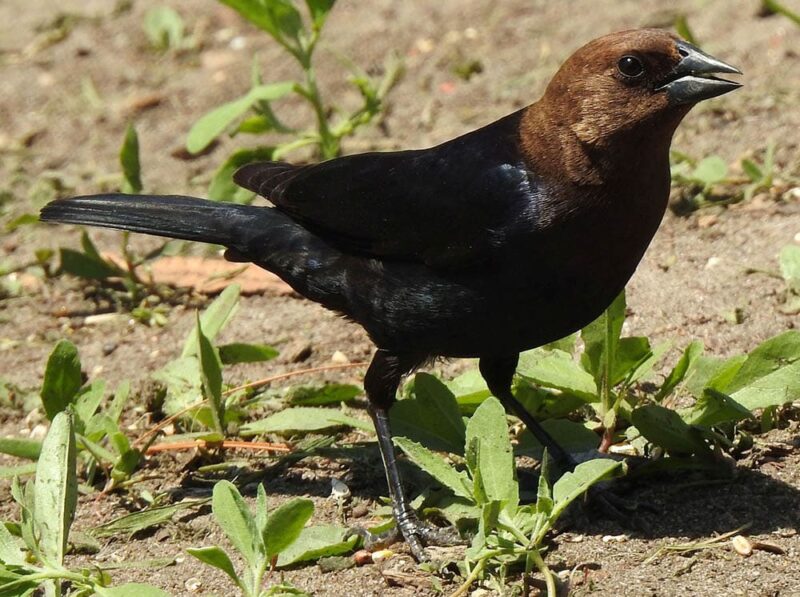
| Length | 7.5 to 8.5 inches |
| Wingspan | 14 inches |
| Weight | 1.5 to 1.9 ounces |
The Brown-headed Cowbird is a blackbird that is common in North America. This bird gets its name from its habit of following cows around and eating the insects that they stir up.
The male Brown-headed Cowbird has a chocolate brown head and neck, with the rest of its body being black. The female brown-headed cowbird is duller in color, with a brown head and neck and a grayish body.
8. Common Grackle
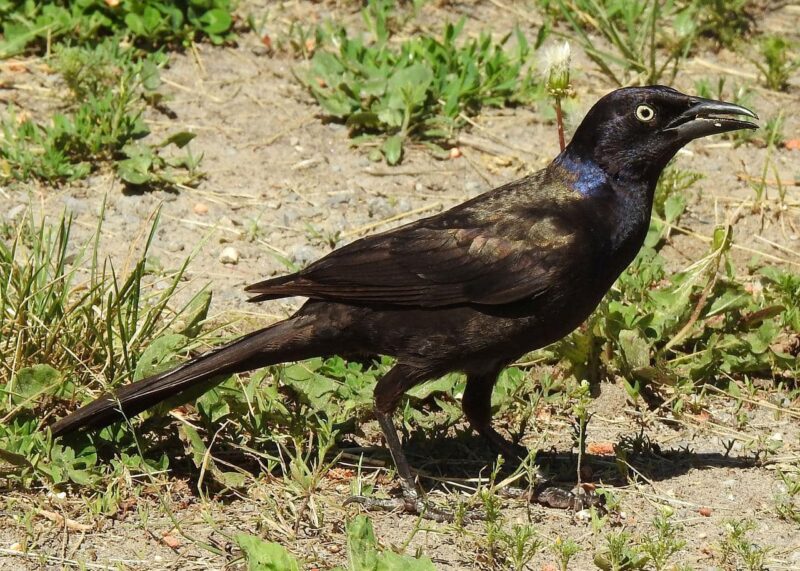
| Length | 10 to 12 inches |
| Wingspan | 15 inches |
| Weight | 2.5 to 5 ounces |
The Common Grackle is a bird in the New World blackbird family. Grackles are highly intelligent and adaptable birds. They are known to be aggressive towards other animals, including humans. The common grackle is found in North America east of the Rocky Mountains.
Common grackles are about 10–12 inches long with a wingspan of about 15 inches. They are black with a long, slender bill. The male common grackle has a purple sheen to its feathers. The female common grackle is duller in coloration.
Common Grackles are found in woodlands, fields, and marshes. They prefer habitats with open areas and trees. They will also live in urban areas and eat insects, earthworms, snails, and other invertebrates. But they will also eat fruits, grains, and nuts.
The Common Grackle is a fairly common bird in Indiana. It can be found in most parts of the state.
9. Rusty Blackbird
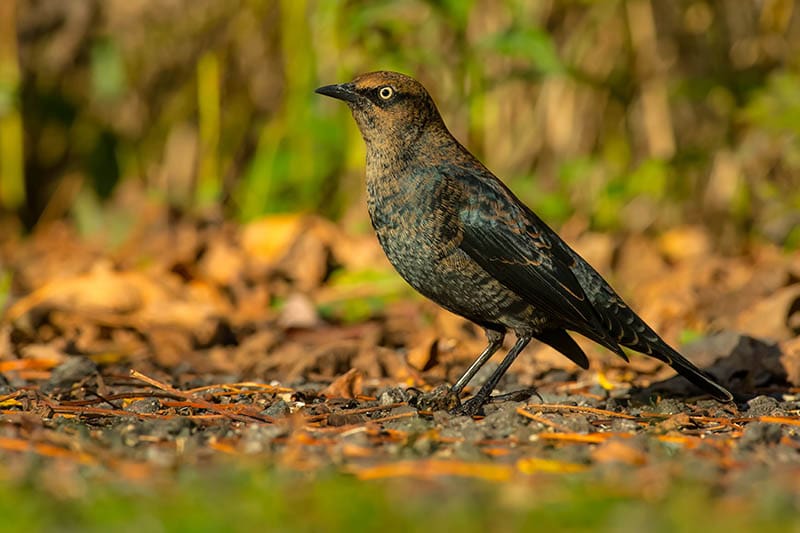
| Length | 9 inches |
| Wingspan | 15 inches |
| Weight | 1.7 to 2.9 ounces |
The Rusty Blackbird is a species of true blackbird. The male has entirely black plumage, while the female is dark brown. As suggested by its name, this bird is most often seen in wooded areas near wetlands. It can be found in all parts of Indiana.
It features a wingspan of 15 inches and a length of 9 inches. The Rusty Blackbird is on the decline due to habitat loss and is now considered to be a threatened species.
10. Brewer’s Blackbird
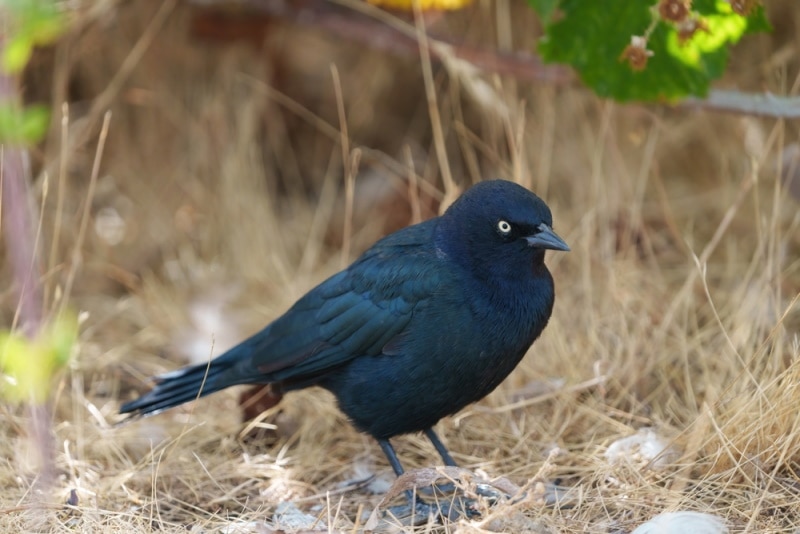
| Length | 7.9 to 9.8 inches |
| Wingspan | 14.5 inches |
| Weight | 1.8 to 3.0 ounces |
The Brewer’s Blackbird is one of the most common blackbirds in North America. It was named after Thomas Brewer, who first described the bird in 1843. This bird can be found in open woodlands, fields, and marshes.
The Brewer’s Blackbird is mostly black with a purple sheen on its feathers. Its eyes are yellow, and its beak is black. This blackbird can grow to be about 8 inches long.
11. European Starling
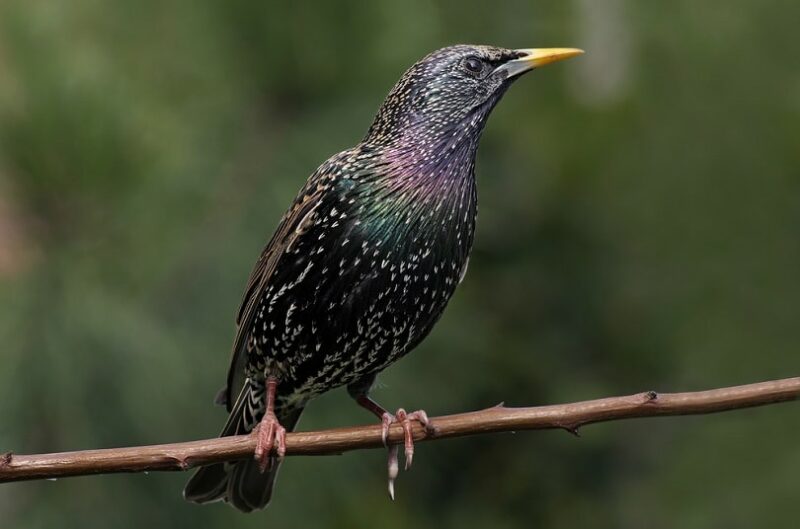
| Length | 7.9 to 9.2 inches |
| Wingspan | 12 to 15 inches |
| Weight | 2 to 3.5 ounces |
The European Starling is an invasive species in the United States, having been introduced in the 1890s. These black birds are small, with short tails and pointed wings. They are found in woodlands, fields, and suburbs, and often gather in large flocks.
Most males are black with green and purple iridescence, while females are dark brown. Both sexes have yellow eyes. Juveniles are mottled brown.
12. Great-Tailed Grackle

| Length | 15 to 18.1 inches |
| Wingspan | 18.9 to 22.8 inches |
| Weight | 3.5 to 6.7 ounces |
The Great-tailed Grackle is the largest member of the icterid family in North America. It measures up to 18.1 inches long and weighs as much as 6.7 ounces. Adult males have black plumage, yellow eyes, and a very long tail.
Females are similar but are smaller and have shorter tails. The Great-tailed Grackle is found in open areas in the southern United States, Mexico, and Central America.
13. Audubon’s Oriole
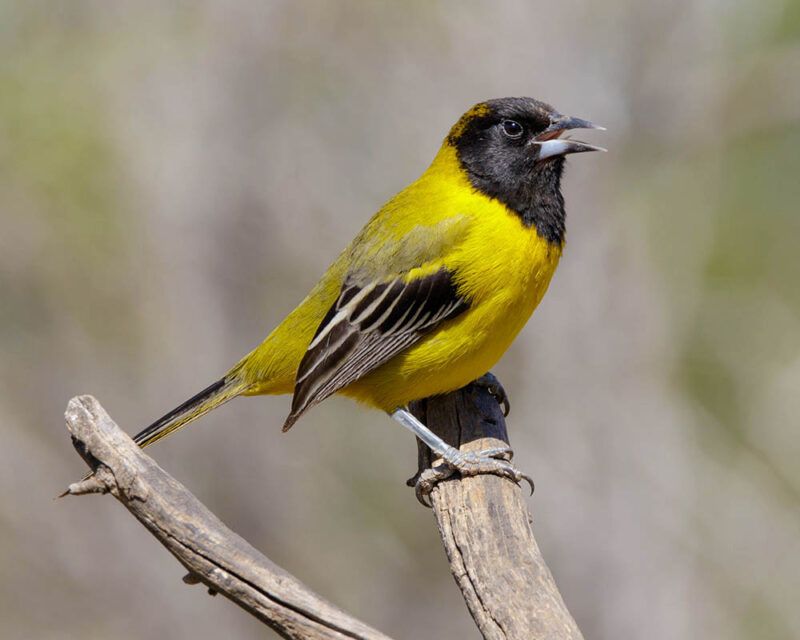
| Length | 7.5 to 9.5 inches |
| Wingspan | 12.5 inches |
| Weight | 1 to 2 ounces |
The Audubon’s Oriole is a small blackbird with a very thin, down-turned bill. They are found in the southern parts of the United States and Mexico. The male has a yellow breast and belly with white wing bars. The females are duller in coloration. These birds eat insects and fruits.
One of the ways to tell an Audubon’s Oriole apart from a Baltimore Oriole is by their call. The Audubon’s Oriole has a Single Note Call that sounds like “chip,” while the Baltimore Oriole has a Rattle Call that sounds like “whip-poor-will.”
14. Bullock’s Oriole

| Length | 6.6 to 7.5 inches |
| Wingspan | 12 inches |
| Weight | 1 to 1.5 ounces |
The Bullock’s Oriole is one of the most beautiful black birds in the state. It is a medium-sized songbird with a long, curved beak. The male has a black body with orange shoulders and a white belly. The female is mostly brownish-black with some white on her belly and wings.
While the Bullock’s Oriole isn’t native to Indiana, they have been spotted in the state on occasion. These beautiful birds are most often found in woodlands near streams, where they feast on insects, berries, and nectar. If you’re lucky enough to spot one of these rare birds in Indiana, be sure to take a picture!
15. Western Meadowlark
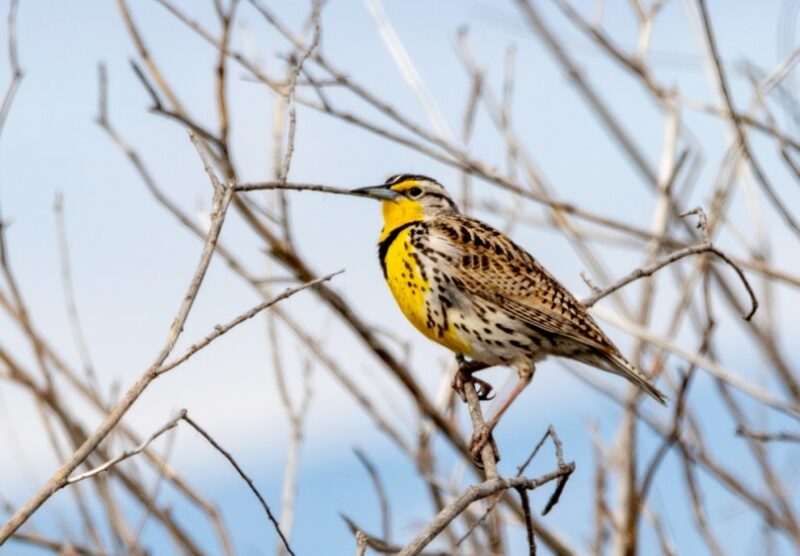
| Length | 6 to 10 inches |
| Wingspan | 16 inches |
| Weight | 3 to 4 ounces |
The Western Meadowlark is a medium-sized blackbird with distinctive yellow markings on its head and breast. It is the state bird of North Dakota, Montana, and Wyoming. The Western Meadowlark breeds in open grasslands across the Western United States and parts of Canada. It winters in the Southern United States, Mexico, and Central America.
The Western Meadowlark is about the same size as a robin. It has a black tail with white edges and yellow bars on its wings. The male western meadowlark has a yellow breast with a black V-shaped mark. The female Western Meadowlark has a streaked brown breast.
The Western Meadowlark eats mostly insects, but it will also eat berries and seeds. It forages on the ground, picking up food with its bill. Western Meadowlarks are vocal birds. Its song is a series of flute-like notes that rise and fall in pitch. It also has a call that sounds like “chick-a-ree.”
This bird nests on the ground, usually in a grassy area. The female builds the nest out of grass and other plant material. She lays three to five eggs, which are tan with brown spots.

Final Thoughts
We hope you enjoyed learning about the different types of black birds in Indiana! These stunning creatures are amazing to watch and photograph, and we’re sure you’ll agree that they add a lot of beauty to the state.
Be sure to keep an eye out for these birds the next time you’re out and about in Indiana, and don’t forget to share your photos for the world to see.
Featured Image Credit: Jo Kleeb, Shutterstock
Table of Contents
- The 15 Types of Black Birds in Indiana
- 1. Yellow-Headed Blackbird
- 2. Eastern Meadowlark
- 3. Bobolink
- 4. Baltimore Oriole
- 5. Red-Winged Blackbird
- 6. Orchard Oriole
- 7. Brown-Headed Cowbird
- 8. Common Grackle
- 9. Rusty Blackbird
- 10. Brewer’s Blackbird
- 11. European Starling
- 12. Great-Tailed Grackle
- 13. Audubon’s Oriole
- 14. Bullock’s Oriole
- 15. Western Meadowlark
- Final Thoughts
About the Author Robert Sparks
Robert’s obsession with all things optical started early in life, when his optician father would bring home prototypes for Robert to play with. Nowadays, Robert is dedicated to helping others find the right optics for their needs. His hobbies include astronomy, astrophysics, and model building. Originally from Newark, NJ, he resides in Santa Fe, New Mexico, where the nighttime skies are filled with glittering stars.
Related Articles:
Monocular vs Telescope: Differences Explained (With Pictures)
10 Types of Hummingbirds in Arkansas (With Pictures)
8 Types of Hummingbirds in Nebraska (With Pictures)
5 Types of Hummingbirds in Idaho (With Pictures)
3 Types of Hummingbirds in Mississippi (With Pictures)
8 Types of Hummingbirds in Kansas (With Pictures)
5 Types of Hummingbirds in West Virginia (With Pictures)
5 Types of Hummingbirds in Ohio (With Pictures)
